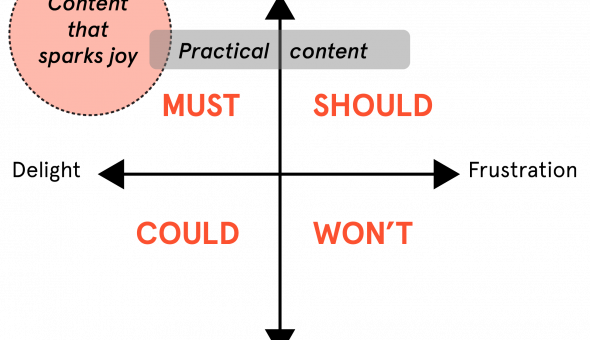The Kondo Way
Kondo’s goal is to change people’s lives by discarding, sorting and organizing clutter. As she, herself, says: “A dramatic reorganization of the home causes correspondingly dramatic changes in lifestyle and perspective. It is life transforming.”
Her method follows eight basic steps:
1. Commit yourself to tidying up: Realize that cleaning will be a process that requires a time investment as well as undistracted focus on the task ahead.
2. Tidy all at once: Rather than organizing items over a long period of time, Kondo’s method advises you to set a deadline for the initial cleaning process.
3. Imagine your ideal lifestyle: Know where you are headed, and realize that clutter holds you back. Embrace this mentality before you begin organizing.
4. Tidy by category, not by location: For example, pile up all clothing items from anywhere in the house. Only then you are fully aware of what you actually have (and it’s probably more than you knew).
5. Follow the right order: Kondo recommends processing the less sentimental items first. In the home, this means moving from clothes to books to papers to miscellaneous items and, finally, to mementos.
6. Ask yourself if items spark joy: This is probably the step you’ve heard of even if you haven’t read Kondo’s book. And it’s the moment that made me fall in love with her method. For each item you consider keeping, hold it in your hand and feel the joy it creates inside you. If a certain sweater makes you feel good and it actually adds value to your life, keep it. If not, discard it.
7. Finish discarding before moving to the next category: Don’t mix items from the books and clothes categories for example. You’ll be distracted and might lose your tidying momentum. As you discard items, it is important to appreciate them. Marie Kondo expresses gratitude by saying thank you for the way an item served its owner in the past.
8. Keep it tidy: A neat organization structure will help to stay within your ideal state of cleanliness that you have defined earlier.
“Okay, my socks are in order,” you may think, “now what exactly does that have to do with my website?”
I believe the principles Marie Kondo teaches can easily – and effectively – be applied to your content strategy, and will provide you with a no-nonsense framework to overhaul your existing web content. At Robert E. Kennedy Library, we are in the process of strategically aligning our content to user experience and position it better within the Cal Poly brand, and at least in my own mind, I’m trying to take a KonMari approach to this work.
Here’s how I envision the eight Content KonMari steps playing out on my institution’s website, based on the principles above:
1. Commit to cleaning up the website: Not unlike your wardrobe, you first have to acknowledge that your website has an issue (let’s be honest, most higher education websites do). Make a pledge to declutter your website!
As a staff designer, it is essential for me to involve stakeholders. I wrote up a strategic document outlining issues I found with the current library website: outdated content, bloated pages, and navigation that makes it hard for users to consume the content on the page. I presented the data to the Dean, which helped to emphasize the importance of the process and sped the process along.
2. Make it a special event: Declaring “we’ll clean up the entire website by 2022” is rarely an effective strategy. Prioritize your objectives and make the process immediate and time-bound, i.e. cleaning up all tutorials on your website as a summer project. Setting a specific goal makes it measurable and achievable, and keeps it relevant for your organization (SMART goals!).
3. Visualize your destination: Ask yourself “What does the ideal higher ed website look like?” This is a great time to conduct competitor research or hold design workshops for all stakeholders involved. You will likely recognize the potential of what you already have. Don’t forget that tidying up doesn’t mean starting from scratch. It’s about being selective, reorganizing and making existing content useful and accessible.
4. Tidy by content category: As Marie Kondo wisely noted, cleaning up all at once usually doesn’t lead to success. It’s easy to get distracted and forget the focus on the goal. Her defined categories can be translated into the following content categories:
Marie Kondo’s KonMari
|
Content KonMari
|
| Clothing |
Interactive content: things you can do
(reserve a room, chat with librarians, find a book) |
| Books |
Useful information like help topics
(how to cite, how to use Google scholar) |
| Papers |
“Stale” information like policies
(collection policy, food and drink policy) |
| Komono (miscellaneous items) |
Multimedia items
(PDF, videos, images) |
| Mementos (sentimental items) |
Archival information
(old blog posts, retirement party pictures) |
Don’t consider the current website structure when tidying the KonMari way. Instead, your categories should be overarching types of content rather than “things that are currently in the ‘About and Contact’ section of the website.” This would limit your tidying options and won’t allow you to fully commit to the process. Again, think of what this can be and should be, not what it is today.
5. Start by discarding: I won’t lie: This is the hardest and, quite frankly, the least interesting part of tidying up a website. But a detailed content audit is absolutely necessary and important to expose all current content, including. how many pages you have, what type of content it is, where it is currently located, and how it is organized.
Create an Excel doc that (at a minimum) lists each page by name, link, author, time of last update. You can then begin a simple qualitative analysis of your content by using the OUCH analysis. Mark each page with:
- O for outdated content
- U for unnecessary content
- C for current content
- H for content that has yet to be written
In a deeper examination, you can further define the target audience and purpose of the page, whether the message is consistent with brand guidelines, and what multimedia or calls to action are used.
6. Spark joy in users: We often struggle to identify the intrinsic value of our websites. At the same time, budget for user studies is often limited, which makes proving value for the target audience seemingly complicated and time-consuming.
Gathering research data, and validating and prioritizing user needs doesn’t need to be rocket science though. A quick way to is to create basic user journeys and stories. Think of some of the main scenarios that apply to a use case of your website.
For my institution’s academic library, for instance, a typical story could be:
- WHO: As a first-year Liberal Arts student
- WHAT: I want to know how to find sources
- WHY: So I can finish my paper tomorrow
A short story like this allows you to map the user’s path through your website. In our case, it takes the student five steps to actually get to the page that contains relevant information. Quickly and logically mapping a user’s emotions during each step allows you to see that this is a rather frustrating process that definitely doesn’t spark joy. In fact, it probably adds to the stress the student a student conducting research already feels.

This is where I like to include and blend the MoSCoW prioritization method (must-haves; should-haves; could-haves; will not have at this time), and the Kano Model for quality management (a ‘less-is-more’ approach to applying products to end-user needs) with the KonMari method. Combining these complementary approaches gives you an intuitive overview of what your site’s joy-inducing content could be.

The goal is to understand stakeholder and user needs, and discard as much information as possible that is not relevant to your users.
7. Designate the right place: Now that you know what is important to them, you can define strategies that will guide your users through a successful online experience. To do that, the information needs to be easily found by your visitors – your content needs to be discoverable.
Marie Kondo’s KonMari
|
Content KonMari
|
| Fold it |
Shorten your content |
| Stand it upright |
Make it discoverable |
| Store it in one spot |
Don’t duplicate information |
| Divide storage into square compartments |
Create sub-categories that make sense |
Kondo makes items like t-shirts discoverable by folding them into origami-like packages and standing them upright in small boxes in a single location in the house. Your t-shirt drawer becomes a file folder system – it’s genius.
You can do something similarly effective, applying these concepts to your websites by creating shorter, simpler content, eliminating content duplication and making content discovery simple with an intuitive navigation. As Kondo says in her book: “[We] should be choosing what we want to keep, not what we want to get rid of.”
8. Keep it tidy: To keep your web content up-to-date and joyous, maintenance and governance must be a priority for you and your team. Formalized content governance includes:
- Clearly defined brand, voice, and style guidelines
- Regular workflow analysis
- Best practices for writing on the web
- SEO best practices
- A shared editorial calendar
Establishing a web steering committee can help to identify and utilize subject matter experts in your organization. Assigned content ownership helps you to set criteria and expectations for the authors. A shared calendar might be useful to remind content editors of their responsibilities. I wrote and published a short orientation guide on how to write for the web for our internal team. Together, we are mapping out all communication channels and try to reuse content whenever possible.
While it seems like a big undertaking, the step-by-step structure and organized approach that KonMari provides makes a content overhaul achievable, structured and fun. I now love my digital messes, too, as I love the feeling after tidying up and knowing we spark joy in our users (and that’s a big achievement for any university website).






